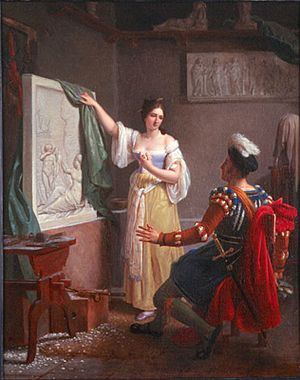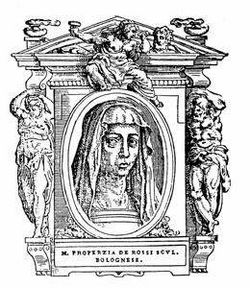Properzia de' Rossi facts for kids
Properzia de' Rossi (born around 1490 in Bologna, died 1530 in Bologna) was an amazing female Italian Renaissance sculptor. She was the only woman to have her life story written about in a famous book called Lives of the Artists by Giorgio Vasari. Vasari said she learned to carve by working with tiny peach stones. Near the end of her life, even the Pope, Pope Clement VII, wanted to meet her. Sadly, she died before he could arrive.
Contents
Properzia's Early Life and Art Skills
Properzia de' Rossi was born in Bologna, Italy. Her father, Giovanni Martino Rossi da Modena, was a notary, not an artist. This was quite unusual for women artists back then. She studied many things, like painting, music, dance, poetry, and old classical books. Some say she even studied with a sculptor at the University of Bologna.
Vasari wrote that Properzia was also good at "household matters." He said she played music and sang better than any other woman in her city. When she was young, she wasn't sure what kind of art she wanted to do. But she found her path when she tried sculpture. She made small, very detailed artworks on fruit stones, like apricots, peaches, and cherries. Some people think Vasari might have made up this story to explain how a woman learned to sculpt.
These tiny carvings often showed religious scenes. One famous one was a Passion of Christ scene with Apostles and the Crucifixion carved into a peach stone. This carving is thought to be part of a necklace. Other examples are in museums today. Vasari also said she copied drawings by the famous artist Raphael using pen and ink.
Big Art Projects and Commissions
In 1525, Properzia was one of several artists chosen to work on the San Petronio Cathedral in Bologna. They were creating stone carvings (called reliefs) showing scenes from the Bible. Vasari said Properzia asked for this job. To show her skill, she carved a marble statue of Conte Guido de' Pepoli. Everyone loved it!
Church records show she was paid to create three sibyls (women from ancient times who could see the future), two angels, and two bas-relief panels. One of these panels shows Joseph and Potiphar's Wife. In this scene, Joseph tries to get away from an Egyptian officer's wife. Properzia showed the muscles and clothing in a very skilled way. This showed her knowledge of ancient art. Her style was modern, like other famous artists of her time.
The story of Joseph escaping temptation was important during that period. It showed the dangers of bad behavior. The second panel is thought to be the Visit of the Queen of Sheba to Solomon. Vasari wrote that Properzia was paid "a most beggarly price" for her work. He blamed another artist, Amico Aspertini, for trying to hurt her chances and pay. Vasari said she never worked for the Cathedral again after 1526, and records support this.
In 1526, she also created an engraved marble piece for the Church of Madonna del Baraccano in Bologna.
Properzia's Later Life and Fame
Vasari claimed that later in her life, Properzia became a very famous engraver. However, no works by her in this style have been found. Vasari wrote that her fame spread all over Italy, even reaching the Pope.
Properzia died on February 24, 1530. This was the same week that Charles V was crowned by Pope Clement VII in Bologna. Pope Clement VII was told that Properzia was a "noble and elevated genius." He heard about her death just as he was on his way to meet her. She was buried in the Della Morte hospital, as she wished in her will. Vasari said that people in her city thought she was "one of the greatest miracles produced by nature in our days."
Properzia in Vasari's Lives
Even though there were many woman artists in Renaissance Italy, Properzia was the only woman included in Vasari's famous book of artist biographies. In her story, Vasari mentions ancient women who achieved great things. He also talks about women writers of his time. Then he says that women artists, with their "little hands, so tender and so white," bravely worked with marble and chisels to become famous. He then describes Properzia's achievements.
Some experts think Vasari's story about Properzia might have been shaped by old ideas about women. But it can also be read in more complex ways. For example, Vasari wrote that Properzia was able to carve the scene of Joseph and Potiphar's wife so well because she had once had a crush on someone who didn't like her back. He said that by carving this piece, she was able to express those feelings. This idea was common back then, suggesting that women's feelings could influence their art.
Properzia's Lasting Impact
Gian Paolo Lomazzo also wrote about Properzia. He added more details to the story about the Joseph and Potiphar's wife artwork. He even compared her to sad women from ancient stories, like Sappho.
Felicia Hemans wrote a poem called ![]() Properzia Rossi. in her book Records of Women (1828). This poem focused on Properzia's unrequited love. It was based on a painting by Louis Ducas from 1822. For Hemans, Properzia was a female artist who went beyond just being a muse (someone who inspires art). She freed herself from old gender roles by creating her own art. In 1828, a play about Properzia's life by Paolo Costa was also published and performed. This play also focused on her unrequited love, which eventually led to her death.
Properzia Rossi. in her book Records of Women (1828). This poem focused on Properzia's unrequited love. It was based on a painting by Louis Ducas from 1822. For Hemans, Properzia was a female artist who went beyond just being a muse (someone who inspires art). She freed herself from old gender roles by creating her own art. In 1828, a play about Properzia's life by Paolo Costa was also published and performed. This play also focused on her unrequited love, which eventually led to her death.
In 1830, the Accademia delli Belli Arti of Bologna celebrated Properzia. They honored her and other early modern women artists. They noted her special role as a sculptor. They also defended her against Vasari's idea that she was a woman who couldn't handle strong feelings.
|
See also
 In Spanish: Properzia de’ Rossi para niños
In Spanish: Properzia de’ Rossi para niños



